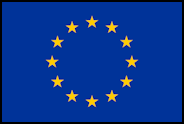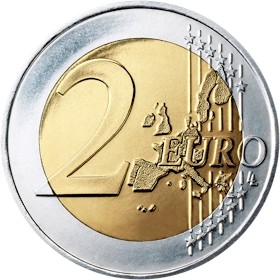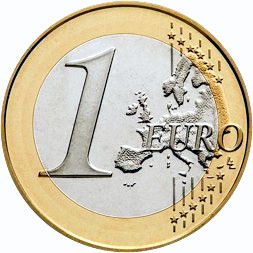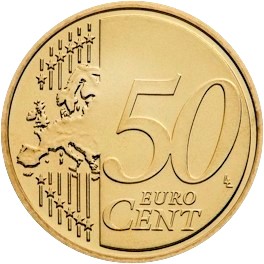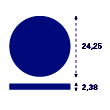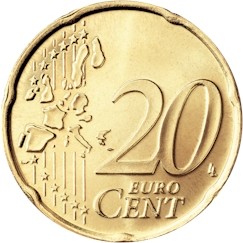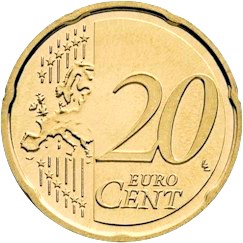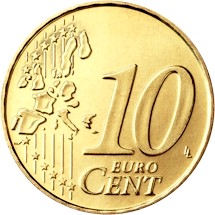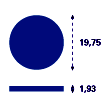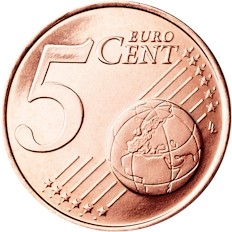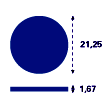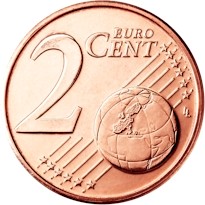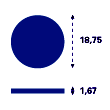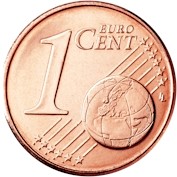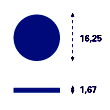| Special Characteristics: |
- Luc Luycx of the Royal Belgian Mint won a Europe wide competition to
design the euro coins. We can see his marc, two 'L's one over the other,
in all the euro common faces.
- Milled edges have been introduced to make it easier - especially for
those with impaired sight - to recognize different values.
- On the 10-cent, 20-cent and 50-cent coins, the numeral, representing
the value of the coin, appears on the right-hand side of the common
face.
Horizontally, below the numeral, appear the words ‘EURO CENT’,
the latter placed below the former.
The word ‘CENT’ is written in
larger letters with a major capital ‘C’.
Six straight lines run
vertically between the lower and upper left hand side of the face.
12 stars are superimposed on these lines, one just before the two
ends of each line.
Superimposed on the mid- and upper section of
these lines, the European continent is represented.
The initials
‘LL’ of the engraver appear between the numeral and the edge on the
right-hand side of the coin.
- On the 1-euro and the 2-euro coins, the numeral, representing the
value of the coin, appears on the left-hand side of the common
face.
Six straight lines run vertically between the lower and upper
right-hand side of the face.
12 stars are superimposed on these
lines, one just before the two ends of each line.
The European
continent is represented on the right-hand side of the face.
The
right-hand part of the representation is superimposed on the mid-section
of the lines.
The word ‘EURO’ is superimposed horizontally across the
middle of the right-hand side of the face. Under the ‘O’ of EURO, the
initials ‘LL’ of the engraver appear near the right-hand edge of the
coin.
- The new European map present on the new common sides of these
denominations, though they are disproportionately large, include the
islands of Malta and Cyprus. These countries will enter the Euro Zone on
1 January 2008.
- The common side of the 1 and 2 Euro coins and the 10, 20 and 50 euro
cent coins changes beginning 1 January 2008 for Austria, Italy,
Portugal, Spain, San Marino and Vatican City. The other members of the
Euro Zone have changed on 1 January 2007.
As agreed by the
informal Economic and Finance Ministers' Council of Verona in April 1996,
the euro coins have a common side and a national side. For the selection
of the design of the first common sides, a competition was organized at
European level, and on 16 June 1997 the Amsterdam European Council decided
and made public the winning series. Photographs of the common sides,
together with a brief factual description of the designs, were published
in the Official Journal (1). On 7 June 2005 the Council decided that the
common sides of the 10-, 20- and 50-cent coins and the 1- and 2-euro
coins, which currently represent the European Union before it was enlarged
from 15 to 25 Member States in 2004, should be modified so that all Member
States of the European Union will in the future be represented. The common
sides of the smallest denomination coins (1-, 2- and 5-cent) represent
Europe in the world and are not affected by the enlargement of the
European Union.The new common sides will be applied as from 2007. The
Member States adopting the euro from 2007 onwards will only issue euro
coins with the new common sides. The Republic of Slovenia will be the
first of the new Member States to do so. Current euro-area Member States
may also start to apply the new common sides as from 2007 for new coin
production, and will in any event switch to the new common side by 2008 at
the latest.
From: "New common sides of Euro circulation coins" Official
Journal of the European Union; 19.9.2006; C 225/7 (1) OJ C 373;
28.12.2001; pp. 1-30.
|


